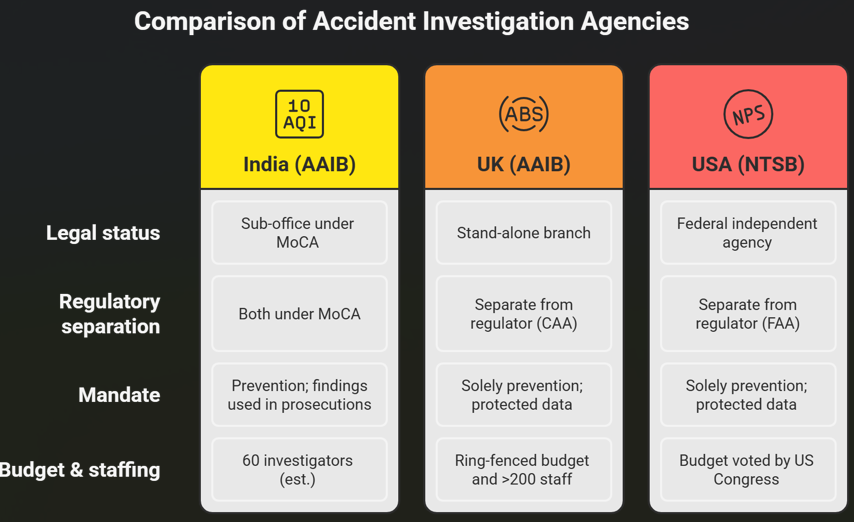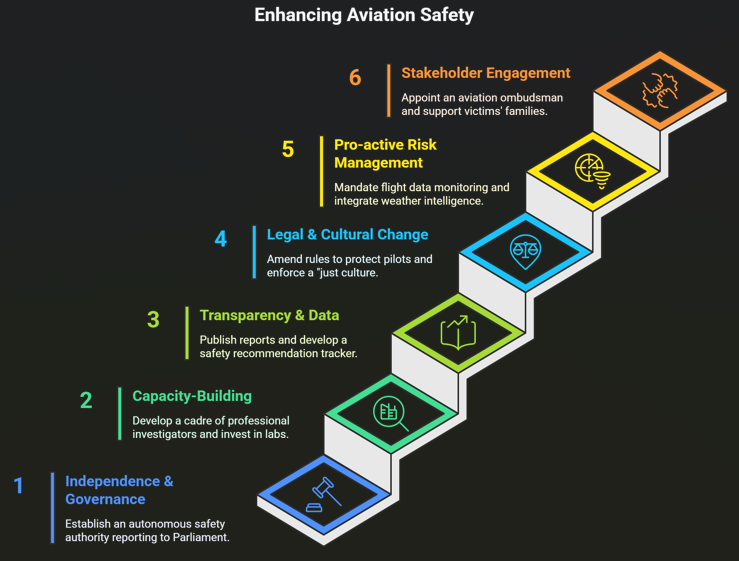Font size:
Print
Aircraft Accident Investigation Reform Can Strengthen Aviation Safety in India
Aircraft Accident Investigation Must Prioritise Truth to Improve Public Trust
Context : Flight AI‑171, a Boeing 787‑8 Dreamliner (VT‑ANB) bound for London‑Gatwick, crashed 30 seconds after take‑off from Ahmedabad, slamming into the B.J. Medical College hostel and killing 279 people (241 on board, 38 on the ground); only one passenger survived .
More in News:
About the Aircraft Accident Investigation Bureau (AAIB)
- Established under Rule 8 of the Aircraft (Investigation of Accidents and Incidents) Rules, 2017, the AAIB is India’s designated accident‑investigation authority
- In practice, it remains an attached office of the Ministry of Civil Aviation (MoCA), and its Director General reports to the Civil Aviation Secretary.
Objective per Rule 3: “prevention of accidents… not to apportion blame or liability.”
- Preliminary data point to a possible dual‑engine power loss linked to electrical failure in the 787’s “more‑electric” architecture, an exceptionally rare scenario now under a multi‑national probe The tragedy is the first fatal full loss of a Dreamliner worldwide and has reignited India’s aviation‑safety debate.
What is the present institutional arrangement for aircraft‑accident investigation in India?
- Statutory design – The Aircraft Accident Investigation Bureau (AAIB) and the Directorate‑General of Civil Aviation (DGCA) are both subordinate offices of the Ministry of Civil Aviation (MoCA). Their heads are appointed, transferred and funded by the same Ministry that frames policy and supervises the airlines they may have to investigate.
- Bharatiya Vayuyan Adhiniyam, 2024 – although it repeals the 1934 Act, it retains MoCA’s “superintendence” over AAIB and DGCA and permits the Centre to review or modify their orders. Thus, structural dependence continues.
- ICAO Annex 13 mandate – international practice requires the investigating body to be “functionally independent” of the regulator and service providers it investigates. India’s model therefore falls short of the global norm.
Expected Mandate of the High‑Level Committee (HLC) on AI‑171
Formed on 14 June 2025 and chaired by Union Home Secretary Govind Mohan, the HLC must
- Ascertain root cause(s) – mechanical, human, weather, regulatory or cybersecurity.
- Audit existing Standard Operating Procedures (SOPs) across operators, ATC, airports, MROs.
- Review emergency response coordination between Union, State & local bodies.
- Benchmark international best practices and draft a new national SOP within 3 months.
- Recommend policy, training and legislative changes and lay out an implementation timeline.

Aviation‑Safety Architecture in India
-
J.K. Seth Committee Report (1997)
-
- Warned that the DGCA “cannot be prosecutor, jury and judge” in cases involving its own oversight; advocated a fully independent investigation bureau with its own cadre and budget
- Called for unified flight‑safety data‑sharing, crew‑resource‑management training, and active stakeholder consultation—recommendations largely shelved.

-
Aircraft Rules 2017 – Key Provisions
-
- Codify ICAO Annex 13 principles: independence, no‑blame, and time‑bound reporting (ideally within 12 months).
- Empower AAIB to issue safety recommendations, maintain a public database, and publish bulletins
- Yet Rule 8(2) keeps AAIB within MoCA, compromising actual autonomy.
What are the Major Lacunae in India’s Investigation Ecosystem
- Institutional dependency: AAIB/DGCA personnel and budgets controlled by MoCA, diluting impartiality.
- Resource deficits: < 50 full‑time investigators for one of the world’s fastest‑growing markets; limited labs and flight‑data decoding capacity.
- Delayed & contradictory reports: many exceed the 12‑month ICAO timeline; inconsistencies (e.g., “entered cloud” vs. clear weather) erode credibility.
- Judicial misuse: AAIB’s technical findings are often treated as legal verdicts, leading to quick “pilot‑error” blame; inhibits a just culture.
- Poor follow‑up: Only a fraction of AAIB safety recommendations achieve “closed‑acceptable action” status.
